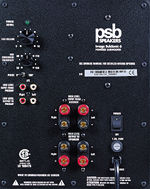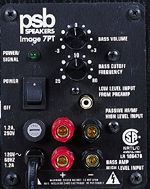PSB Image Series Speaker System Page 2
PSB has never believed in the mini-subwoofer trend, and the Image SubSonic 6 follows the more-traditional practice of using a larger cabinet to get better efficiency and control. The built-in 130-watt power amp is sufficient to drive the ported 12-inch woofer into the low 20s with good authority. Because the moving mass is much lower than that of one of those heavy-duty miniwoofers, the results are more pitch-accurate and tuneful. PSB supplies both low-level and speaker-level inputs, but I used the sub with the low-level LFE output from my pre/pro. You can adjust the crossover frequency between 50 and 150 hertz, but (unfortunately) you can't bypass it.
 With performance cars, there's no substitute for displacement. I would argue that, with speakers, it's the same. Although you can get plenty of volume and surprisingly deep bass out of a puny little woofer-challenged minimonitor, something usually has to give. More often than not, that something is the dynamics. However, with this setup, I was immediately struck by how lively and dynamic everything sounded. No matter how loud I played it, the PSB system never sounded compressed, and this sense of dynamics let everything hang out in an engaging and exciting way.
With performance cars, there's no substitute for displacement. I would argue that, with speakers, it's the same. Although you can get plenty of volume and surprisingly deep bass out of a puny little woofer-challenged minimonitor, something usually has to give. More often than not, that something is the dynamics. However, with this setup, I was immediately struck by how lively and dynamic everything sounded. No matter how loud I played it, the PSB system never sounded compressed, and this sense of dynamics let everything hang out in an engaging and exciting way.
Listening to the 7PTs by themselves in my two-channel system, I thought about how this type of system would've suited me perfectly when I was in college. The 7PT's active bass drivers make it sound like an even bigger speaker than it is, and I was amazed by how much air two 6.5-inch woofers can move. Although this speaker has a slightly cool midrange, refinement is still one of its strong points, with the tweeter integrating well into the overall sound. Some of the other powered towers I've heard tend to have a slightly detached bass that doesn't integrate successfully with the rest of the sound, but not the 7PT. If I didn't know better, I never would've guessed that this speaker has powered bass, yet the benefits of this active approach are clearly evident. The bottom end is amazingly fast and free from overhang or sloppiness, allowing me to clearly hear every funky note and pluck of Les Claypool's six-string Carl Thompson bass on Primus' "Pork Soda." Even large-scale classical recordings didn't faze the 7PTs, and big organ works like Vierne's Symphony No. 5 rocked my listening room.
 In my home theater, the 7PTs had powerful-enough bass to run the system without the SubSonic 6 subwoofer, yet there was no doubt about the benefits of including the dedicated sub. At one point, fellow writer Steve Guttenberg dropped by and wanted to hear the system, so we watched Fight Club. There happened to be a sheet of paper lying on top of a box about 4 feet from both the subwoofer and one of the 7PTs. During sections of the film with loud bass, I noticed that the moving air caused the paper to flutter; then, during the final scene when all of the buildings blow up, the sheet actually lifted up off the box and fell to the floor. Now, I'm not one to judge a system's performance by its paper-moving ability, but this was an unexpected demonstration of the PSB system's ability to crank it out. Dynamics were stunning, and the film's plane-crash sequence had me clutching the arm of my sofa for dear life.
In my home theater, the 7PTs had powerful-enough bass to run the system without the SubSonic 6 subwoofer, yet there was no doubt about the benefits of including the dedicated sub. At one point, fellow writer Steve Guttenberg dropped by and wanted to hear the system, so we watched Fight Club. There happened to be a sheet of paper lying on top of a box about 4 feet from both the subwoofer and one of the 7PTs. During sections of the film with loud bass, I noticed that the moving air caused the paper to flutter; then, during the final scene when all of the buildings blow up, the sheet actually lifted up off the box and fell to the floor. Now, I'm not one to judge a system's performance by its paper-moving ability, but this was an unexpected demonstration of the PSB system's ability to crank it out. Dynamics were stunning, and the film's plane-crash sequence had me clutching the arm of my sofa for dear life.
Although the midrange sounded a touch cool at times, this never got in the way of my enjoyment, and warmer, more-subtle soundtracks like Searching for Bobby Fischer sounded wonderfully detailed and rich. The 9C center is big and dynamic-sounding, but it did occasionally demonstrate a bit of boxiness—no doubt due to some of the big cabinet's resonance. Off-axis, the 9C's response was fairly even, although I could sense some of the lobing effects frequently heard with laterally arranged drivers like this one. Overall, the 9C is impressively transparent, and it helps you easily understand dialogue buried deep in the mix.
I usually prefer the sound of a direct-radiating surround speaker, but the 10S manages to keep the benefits of a direct-radiator while mixing in some of the advantages of a dipole, particularly the wider listening window. The surround image was well-focused, with plenty of detail and speed, while the transitions from surround to front were well-integrated and smooth, due to the speakers' similar sonic fingerprints.
Subwoofers are perhaps the most difficult speakers to get right in an affordable system, and many of them are little more than boomboxes that just add a thump for sound effects. The SubSonic 6 is the first sub I've seen for under $1,000 that really can be used effectively for both music and effects, as it is surprisingly tuneful and quick-sounding. Yet, for those big, pounding sound effects, it still delivers the goods in a truly impressive way.
Paul Barton has done it again, developing a line of speakers with performance that goes way beyond what you'd expect for the price. It's clear that this is no accident: It comes from years of careful listening, combined with the resources needed to make a cost-effective design. I'd recommend this system to anyone.
Highlights
• Modular design creates great coherency between the different models
• Powerful, articulate, engaging sound
• How can they perform this well for the money?
Image 7PT Tower Speaker $1,449/pair
Image 9C Center-Channel Speaker $399
Image 10S Surround Speaker $649/pair
Image SubSonic 6 Subwoofer $649






























































